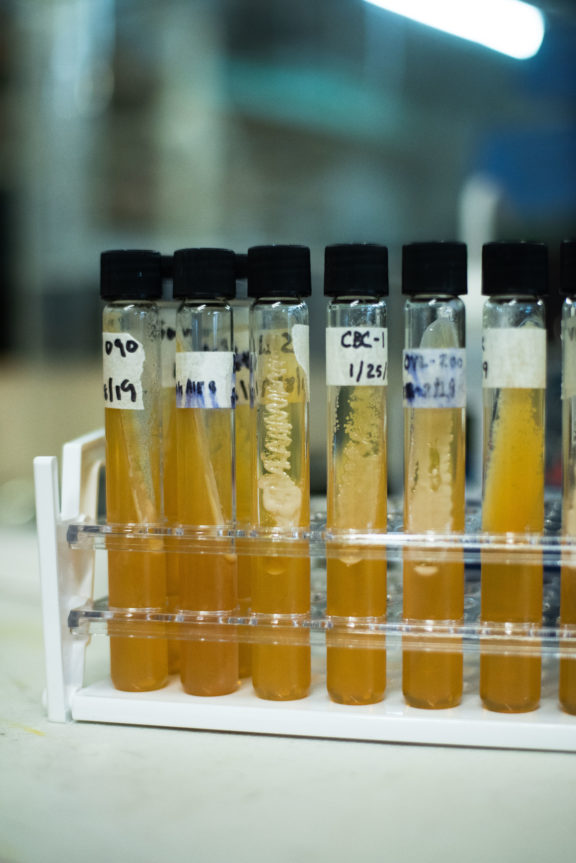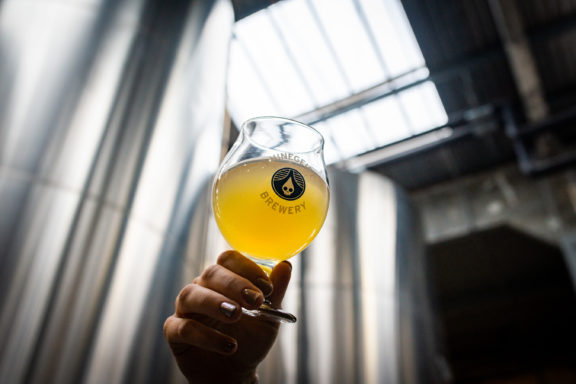Yeasty Boys: In House Cultures
“We brewers don’t make beer, we just get all the ingredients together and the beer makes itself.” — Fritz Maytag
Yeast. It surrounds us and penetrates us. It binds the beer galaxy together.
Yeast’s primary role in brewing is to eat up sugars in the malt and convert them to ethyl alcohol and carbon dioxide, but this process adds so much more to the finished product. These single-cell organisms contain a treasure trove of fermented possibility for taste and smell, from banana to black pepper to bubblegum and beyond. While we’re (rightfully) known as hop heads here at Rhinegeist, we’d be remiss not to give yeast its due. Our production team has been slowly amassing a library of different cultures, tinkering with malts, temperatures, and flavor profiles. To get a grip on the eukaryotic chaos, we sat down with our Yeast Wrangler in Chief, Nick Ketchum.
That’s No Moon
Nick works out on an office in our basement, a modest room nicknamed “The Death Star” nestled between our oak foeders and the woodshop. A mini-fridge houses the yeast library, a collection of test tubes that Nick pulls from as needed to propagate specific strains, and a microwave keeps small boxes of assorted grains.

With a turntable in one corner and a 3D printer in another, the place feels somewhere between a garage and a microbiology lab. Bags of rice are stacked by the door, a carboy filled with wort fermented using Norwegian farmhouse yeast occupies the center of the room, and a small stack of shelves house scientific journals and beer bottles.
“This whole thing was outfitted for pretty cheap,” Nick says. “Mitch [Dougherty, Barrel Master] helped me pull together some old equipment. We purchased a few things and I brought in some stuff from home.”
A member of our lab team, Ketchum describes the yeast propagation program as “partly practical, but also a magnificent boondoggle of pure imagination and creativity.”
On the practical side, fulfilling our yeast needs in-house lowers costs and improves quality. A delayed or damaged shipment can throw a serious wrench in the production schedule, and having a diversity of cultures at our fingertips allows for detailed fine-tuning throughout the brewing process, playing around to find which yeast make our beers taste the absolute best.
As our library grows, so do our possibilities. Peter Mooney, longtime brewer, has been tinkering on the 8.5 BBL innovation system at our Spring Grove Ave distribution facility. As he and the production team think up new ideas and recipe tweaks, Nick grabs yeast from the library and propagates according to their needs. (Pro-tip: next time you’re in the taproom, check the boards for the latest Spring Grove release)
It’s not all small time trials, though. The most exciting benefit of this library is the chance to integrate new ideas into our main production schedule, bottling and sharing these unique creations with the wider world.

Nick (left) and Austin (right)

Our 8.5 BBL innovation system at our Spring Grove locale.
The Bee’s Knees
Skeleton Brut was our first foray into using experimental yeast in our main production schedule. A Brut Imperial India Pale Ale, this brew had a few uniquities. We teamed up with our OTR pals at Skeleton Root and added Vidal blanc grape must to the recipe. Most excitingly, the yeast literally came from a bee’s knees. We went up to the Krohn Conservatory in Eden Park, a space formerly used for viticulture by Nicholas Longworth, and used a q-tip to snag a swab from a bee.
“I had zero money on that beer working out,” Nick recalls, laughing. “I propagated the yeast and Austin [Zanella, brewer and lab team member] pitched it. We were equally skeptical but for our own reasons. Being a Brut IPA, we needed 100% attenuation [meaning the yeast eats up all the sugars in the mash]. The bee yeast only had 60 or 70% attenuation, so we added in amyloglucosidase to finish the job.”
The final product was beautiful, intriguing and novel; A punch of tropical hop aroma with a super crisp, dry finish balanced by a white-wine like delicateness.

Into the Outer Reaches
Yeast plays an especially important role in our sours program here at Rhinegeist. The flavor profile that sour and funky beers take on through secondary fermentation is largely determined by the type of yeast chewing on the complex sugars in the (often already “finished”) brew. This yeast is sometimes the result of a conscious choice on the part of a brewer or barrel master, but yeast is ever-present in the air, and often finds purchase as the result of a roll of the -myces-dice.
This is how many traditional, open-fermented sours are created. We don’t open-ferment our sours at Rhinegeist, but we do rely on yeast and bacteria present on the skins of fruits used in the beer to inoculate and orchestrate unique profiles, and we have isolated and used ambient yeast strains.
“The real Willy Wonka stuff,” notes Ketchum, “happens down in the sours world, where we are trying to push the boundaries of the brewing process and develop brewing methods and use organisms that are truly unique and innovative.”
Each of the four foeders in the sours cellar at Rhinegeist is inoculated with its own blend of yeast and bacteria, and each affects the beer in completely different ways during the ageing process. Infinite Dawn, for instance, is rested in foeder one and comes out with a cleaner, more subdued profile in terms of fruit, funk and acidity, while beers that spend time meditating in foeder four—which contains Brettanomyces bruxellensis and our house lactobacillus blend— take on slightly more pineapple and tropical fruit character. Foeder one contains lactobacillus plus our house Brettanomyces, a particularly clean and fruity strain that we pulled from the air in the brewery and banked for proprietary use.
Using our own yeast strain collected from the internal atmosphere of our 150 year old building is a practice that echoes many traditional Belgian breweries, and grants us a strong connection to history—the geist of Cincinnati’s brewing history is very much alive and thriving inside the brewery, quite literally, as yeast passes on its DNA from generation to generation in a manner similar to humans.
You could say we really value culture here at Rhinegeist (we’ll see ourselves out).

Michigan cherries added during secondary fermentation

All our foeders come from our friends at Foeder Crafters.
—
For the budding homebrewer or curious craft drinker, Chris White and Jamil Zainasheff’s Yeast: The Practical Guide to Beer Fermentation offers a comprehensive overview of all things fermentation.